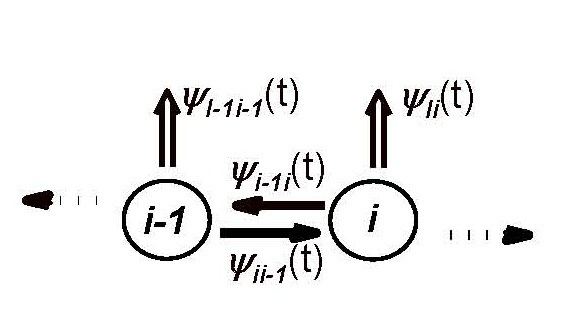 | ||
In studies of dynamics, probability, physics, chemistry and related fields, a heterogeneous random walk in one dimension is a random walk in a one dimensional interval with jumping rules that depend on the location of the random walker in the interval.
Contents
- Random walks in applications
- Formulations of random walks
- Simple systems
- Heterogeneous systems
- Explicit expressions for heterogeneous random walks in 1D
- Path representation of heterogeneous random walks
- Path PDFs
- References
For example: say that the time is discrete and also the interval. Namely, the random walker jumps every time step either left or right. A possible heterogeneous random walk draws in each time step a random number that determines the local jumping probabilities and then a random number that determines the actual jump direction. Specifically, say that the interval has 9 sites (labeled 1 through 9), and the sites (also termed states) are connected with each other linearly (where the edges sites are connected their adjacent sites and together). In each time step, the jump probabilities (from the actual site) are determined when flipping a coin; for head we set: probability jumping left =1/3, where for tail we set: probability jumping left = 0.55. Then, a random number is drawn from a uniform distribution: when the random number is smaller than probability jumping left, the jump is for the left, otherwise, the jump is for the right. Usually, in such a system, we are interested in the probability of staying in each of the various sites after t jumps, and in the limit of this probability when t is very large,
Generally, the time in such processes can also vary in a continuous way, and the interval is also either discrete or continuous. Moreover, the interval is either finite or without bounds. In a discrete system, the connections are among adjacent states. The basic dynamics are either Markovian, semi-Markovian, or even not Markovian depending on the model. In discrete systems, heterogeneous random walks in 1d have jump probabilities that depend on the location in the system, and/or different jumping time (JT) probability density functions (PDFs) that depend on the location in the system.
General solutions for heterogeneous random walks in 1d obey equations (1)-(5), presented in what follows.
Random walks in applications
Random walks appear in the description of a wide variety of processes in biology, chemistry and physics. Random walks are used in describing chemical kinetics and polymer dynamics. In the evolving field of individual molecules, random walks supply the natural platform for describing the data. Namely, we see random walks when looking on individual molecules, individual channels, individual biomolecules, individual enzymes, quantum dots. Importantly, PDFs and special correlation functions can be easily calculated from single molecule measurements but not from ensemble measurements. This unique information can be used for discriminating between distinct random walk models that share some properties, and this demands a detailed theoretical analysis of random walk models. In this context, utilizing the information content in single molecule data is a matter of ongoing research.
Formulations of random walks
The actual random walk obeys a stochastic equation of motion. Yet, the probability density function (PDF) obeys a deterministic equation of motion. Formulation of PDFs of random walks can be done in terms of the discrete (in space) master equation and the generalized master equation or the continuum (in space and time) Fokker Planck equation and its generalizations. Continuous time random walks, renewal theory, and the path representation are also useful formulations of random walks. The network of relationships between the various descriptions provides a powerful tool in the analysis of random walks. Arbitrarily heterogeneous environments make the analysis difficult, especially in high dimensions.
Simple systems
Known important results in simple systems include:
Heterogeneous systems
The solution for the Green's function
The dynamics can also include state- and direction-dependent irreversible trapping JT-PDFs,
Explicit expressions for heterogeneous random walks in 1D
In a completely heterogeneous semi-Markovian random walk in a discrete system of L (> 1) states, the Green's function was found in Laplace space (the Laplace transform of a function is defined with,
Here,
and
Also, in Eq. (1),
and
with
and
For L = 1,
Equations (1)-(5) hold for any 1D semi-Markovian random walk in a L-state chain, and form the most general solution in an explicit form for random walks in 1d.
Path representation of heterogeneous random walks
Clearly,
Still, the formalism used in this article is the path representation of the Green's function
The expression for
We also note that the following relation holds,
Path PDFs
Complementary information on the random walk with that supplied with the Green’s function is contained in path PDFs. This is evident, when constructing approximations for Green’s functions, in which path PDFs are the building blocks in the analysis. Also, analytical properties of the Green’s function are clarified only in path PDF analysis. Here, presented is the recursion relation for
The recursion relation is used for explaining the universal formula for the coefficients in Eq. (1). The solution of the recursion relation is obtained by applying a z transform:
Setting
In Eq. (10)
where
The initial number
and,
